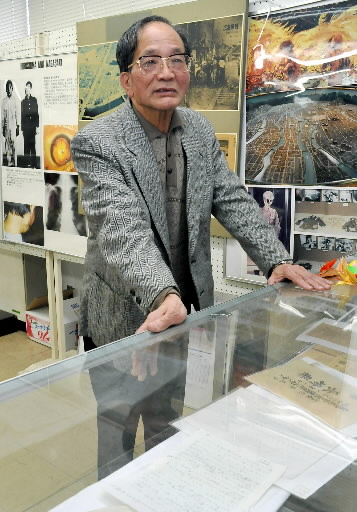Nuclear Weapons Can Be Eliminated: Chapter 9, Part 4
Apr. 20, 2010
Chapter 9: Messengers from Hiroshima
Part 4: Hitoshi Takayama
by Junichiro Hayashi, Staff Writer
About 2,000 people from Japan, including roughly 100 from Hiroshima, among them A-bomb survivors (hibakusha), will head to the United States in time for the Nuclear Non-proliferation Treaty (NPT) Review Conference to be held at U.N. headquarters in New York from May 3-28. They will visit the United States to appeal for the necessity of eliminating nuclear weapons. The Chugoku Shimbun will track their hopes and resolve with regard to the NPT Review Conference as well as the feelings of those who cannot visit the United States due to advanced age or poor health.
The pain he still feels stirs memories of 65 years ago. Hitoshi Takayama, 79, chairman of the Higashi Hiroshima City Association of Atomic Bomb Sufferers, rubbed his scarred waist and wiped away tears.
"I was eager to go," Mr. Takayama said. "I wish I could." He had been planning to travel to the United States for the Nuclear Non-proliferation Treaty (NPT) Review Conference in May. He thought it would be his "last chance" due to advancing age, and his hopes have grown for the abolition of nuclear weapons since U.S. President Barack Obama took office. However, he was hospitalized last fall for over a month. Due to health concerns, he had no choice but to abandon his plans.
Mr. Takayama was exposed to the atomic bombing while working as a mobilized student at a factory in Minami-machi (now Minami Ward, Hiroshima), located about two kilometers from the hypocenter. Although blown into the air by the blast, he did not suffer serious injuries at the time. But in 1962, 17 years after the bombing, a malignant tumor was found on his waist.
He underwent an operation to remove most of the muscles on his left side at a hospital in Hiroshima. He recalls his wife and year-old son smiling at him when they visited him at the hospital. "But I saw a number of other A-bomb survivors lying near me pass away," he said. "I wondered how long I would live. Such thoughts were agonizing."
After leaving the hospital, he returned to work as a Japanese language teacher at a junior high school. In August 1966, he was invited to attend a meeting at the Hiroshima YMCA, where A-bomb survivors shared their experiences, often shedding tears. "I had felt guilty remaining silent," said Mr. Takayama. That meeting became a turning point in his life.
Mr. Takayama began devoting his free time to interviewing A-bomb survivors. Hearing that the consequences of the atomic bombing were barely known overseas, he had the testimonies translated into English after gaining the cooperation of Hiroshima Peace Memorial Museum and other supporters. In 1969, he published a book entitled Recollections of Hiroshima and sent copies to acquaintances in many places, including the United States.
That was a time when the United States and the former Soviet Union were vying to hold the largest arsenal of nuclear weapons. "I hated the United States for dropping the atomic bombs," he said. "But I felt even more strongly about doing whatever I could so the suffering we endured would never have to be experienced by anyone else." After the book was revised and updated, and its title was changed to Recollections of Hiroshima and Today, Mr. Takayama sent copies to the United Nations Headquarters and other places. He received letters of appreciation from the White House and the Vatican, recognizing the importance of conveying the voices of A-bomb survivors.
Since retiring as a teacher at the age of 56, Mr. Takayama has focused on collecting A-bomb-related artifacts. His collected items include an iron helmet with burnt hair stuck inside it and charred trousers. A total of 1,000 artifacts are displayed at two locations, including the Hachihonmatsu Community Center in Higashi Hiroshima City, and are used in peace education activities for children.
"What were the consequences of the atomic bombing? If individuals, families, nations, and the whole world could grasp what happened here, it would lead to the elimination of nuclear weapons," said Mr. Takayama. He has entrusted more than 150 books with the A-bomb testimonies from 44 survivors to his fellow hibakusha and others who will visit the United States for the NPT Review Conference.
(Originally published on April 16, 2010)
To comment on this article, please click the link below. Comments will be moderated and posted in a timely fashion. Comments may also appear in the Chugoku Shimbun newspaper.








